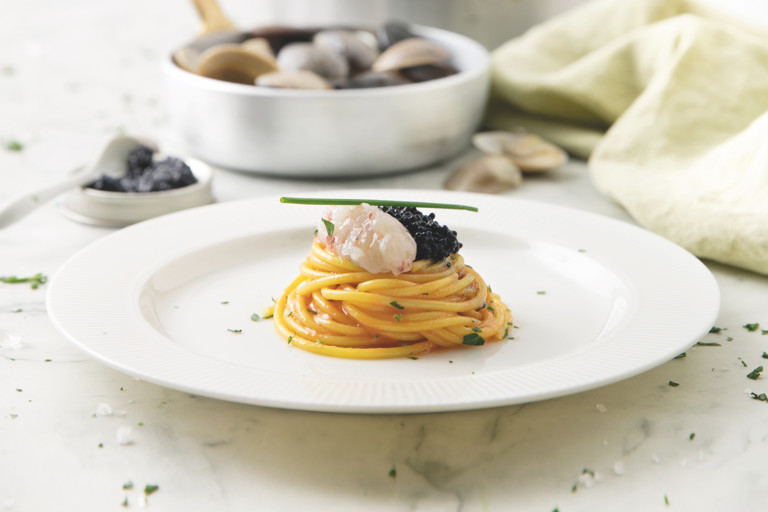Spaghetti alla carbonara di mare
- medium
- 2
- 2 hours
Accursio Lota's seafood carbonara recipe is a clever spin on a classic, using seafood roe of various kinds to create the sauce instead of the traditional hen's eggs. This dish is the winner of the Barilla World Pasta Championships 2017, beating nineteen entries from pasta chefs around the world for the top position.
The future of pasta, in my opinion, will be realised not only by reinventing pasta according to oneself, but by regenerating and reworking the classic accompaniments and sauces in new ways. This doesn’t mean to destroy our traditions, but it means to rethink and reimagine both ingredients and techniques.
I took the carbonara concept and substituted the chicken eggs with seafood eggs. I used green mandarin and red Mazara shrimps, both classic ingredients from Sicily. Then I cooked seafood, scallops, red shrimps, cuttlefish and amberjack fillet at a very slow temperature in guanciale fat, to resemble the rich meatiness of pasta carbonara. I served them on a separate plate from the pasta. In this way we have a new version of “carbonara” with no eggs and no dairy.
Ingredients
Metric
Imperial
Fish stock
- 500g of sole bones
- 500g of squilla mantis
- 1/2 white onion, diced
- 2 celery sticks, diced
- 1 sprig of thyme
- ice
- 3l water
- extra virgin olive oil
Seafood egg base
- 200g of clams
- 200g of mussels
- 30g of tuna bottarga
- 50g of sea urchin roe
- 30g of cured salmon roe
- 20g of scallop roe, taken from the scallops used for the seafood
Prawn stock
- 6 large red prawns, Accursio uses Gambero Rosso di Mazara
- 1 shallot, diced
- 1 celery stick, diced
- 2 garlic cloves, finely sliced
- 250g of ice
- 750ml of water
- extra virgin olive oil
- salt
- white pepper
Seafood cooked in guanciale fat
- 1.5kg guanciale, diced
- 100g of amberjack fillet
- 2 small cuttlefish, whole
- 2 small scallops
- salt
- white pepper
Pasta and sauce
- 100g of spaghetti
- 4 tsp extra virgin olive oil
- 1 shallot, diced
- 1 garlic clove, finely sliced
- 1 red chilli, finely sliced
- 75ml of dry white wine
- 1 tsp parsley, finely chopped
- 1/2 tsp green mandarin zest, organic
- salt
- white pepper
To serve
- 18g of Oscietra caviar
- 2 chives
Equipment
- Fine sieve
- Blender
- Muslin cloth
- Cooking thermometer
Method
- extra virgin olive oil
- 500g of sole bones
- 500g of squilla mantis
- 1/2 white onion, diced
- 2 celery sticks, diced
- 1 sprig of thyme
- ice
- 3l water
- 20g of scallop roe
- 30g of tuna bottarga
- 50g of sea urchin roe
- 30g of cured salmon roe
- 6 large red prawns, Accursio uses Gambero Rosso di Mazara
- extra virgin olive oil
- 750ml of water
- 1 shallot, diced
- 1 celery stick, diced
- 2 garlic cloves, finely sliced
- 250g of ice
Get in touch
Please sign in or register to send a comment to Great British Chefs.

